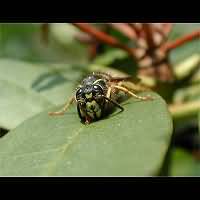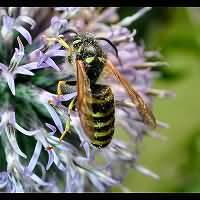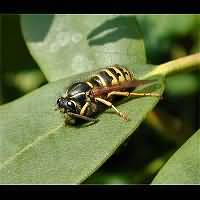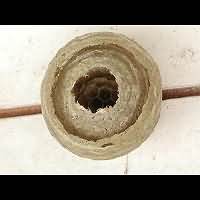Saxon Wasp Dolichovespula saxonica
The Saxon Wasp is black with yellow, stripe-shaped markings. You can't tell much by just looking at the stripes. Anyway, it is very tough identifying wasps by the pattern of the yellow stripes. In case of the Saxon Wasp the lining is highly variable, but the first three or four yellow lines tend to be very small. The Saxon Wasp shares this characteristic with the Medium Wasp, though. The markings on the face are variable too, but the Saxon Wasp usually just has a black hole within the yellow. The hairs are of different colours according to location. Those on top of the thorax are black, those on the side of the thorax are white or grey. All this makes the Saxon Wasp queen and female difficult to identify. Males are even harder still. Best thing is to examine them under the microscope. And that goes for most males of Dolichovespula species. When it comes to size, the Saxon Wasp is quite the ordinary wasp. Queens are between 15 and 18mm long. Workers are relatively small and measure from 11 to 14mm. And reaching a bodily length of 13 to 15mm males are neatly in the middle of all this. The best way identifying this species is by the nest.
The queen starts building a new nest after overwintering. Usually this is in May. The nest is very prominently situated. It hangs freely, but never in open air. Sometimes it is constructed indoors, usually in a stables or in the attic, but more often it is being build outside attached to the gutter or a porch. The nest has a greyish colour, with some yellowish lines or patches as only colourful accents. The outside is smooth without ventilation holes. It is rarely longer than some 25cm. The number of occupants in the nest, including eggs and larvae, is less than 1,000. A nest of the Common Wasp may contain well over 12,000 inhabitants, so the Saxon Wasp has small nests indeed. The nest is always open at the bottom and this opening serves as entrance and exit. Waist simply falls out of the nest and drops to the floor, where we find it in a small heap, called the latrine. A nest contains a maximum of 5 combs, but usually less. The nest construction takes a short time only and the entire population is build up quickly. In September the colony falls apart. The Saxon Wasp is a very friendly animal. It hardly ever stings and is not aggressive in the vicinity of the nest. In autumn it never bothers us on the terrace or the beach.
The Saxon Wasp inhabits large parts of Europe and northern and central Asia. It is absent on the British Isles, though. In the Low Countries and in Northern France it is a very common wasp. Loves to live in the vicinity of people. Nests are being destroyed needlessly. This is due to the fact that the wasp makes it nests at striking locations, where it is usually spotted by people immediately. The destruction of the nests is a pity however, for the Saxon Wasp is an excellent exterminator of flies and other insects. Besides it is far from aggressive towards people.
The Saxon Wasp is black with yellow, stripe-shaped markings. You can't tell much by just looking at the stripes. Anyway, it is very tough identifying wasps by the pattern of the yellow stripes. In case of the Saxon Wasp the lining is highly variable, but the first three or four yellow lines tend to be very small. The Saxon Wasp shares this characteristic with the Medium Wasp, though. The markings on the face are variable too, but the Saxon Wasp usually just has a black hole within the yellow. The hairs are of different colours according to location. Those on top of the thorax are black, those on the side of the thorax are white or grey. All this makes the Saxon Wasp queen and female difficult to identify. Males are even harder still. Best thing is to examine them under the microscope. And that goes for most males of Dolichovespula species. When it comes to size, the Saxon Wasp is quite the ordinary wasp. Queens are between 15 and 18mm long. Workers are relatively small and measure from 11 to 14mm. And reaching a bodily length of 13 to 15mm males are neatly in the middle of all this. The best way identifying this species is by the nest.
The queen starts building a new nest after overwintering. Usually this is in May. The nest is very prominently situated. It hangs freely, but never in open air. Sometimes it is constructed indoors, usually in a stables or in the attic, but more often it is being build outside attached to the gutter or a porch. The nest has a greyish colour, with some yellowish lines or patches as only colourful accents. The outside is smooth without ventilation holes. It is rarely longer than some 25cm. The number of occupants in the nest, including eggs and larvae, is less than 1,000. A nest of the Common Wasp may contain well over 12,000 inhabitants, so the Saxon Wasp has small nests indeed. The nest is always open at the bottom and this opening serves as entrance and exit. Waist simply falls out of the nest and drops to the floor, where we find it in a small heap, called the latrine. A nest contains a maximum of 5 combs, but usually less. The nest construction takes a short time only and the entire population is build up quickly. In September the colony falls apart. The Saxon Wasp is a very friendly animal. It hardly ever stings and is not aggressive in the vicinity of the nest. In autumn it never bothers us on the terrace or the beach.
The Saxon Wasp inhabits large parts of Europe and northern and central Asia. It is absent on the British Isles, though. In the Low Countries and in Northern France it is a very common wasp. Loves to live in the vicinity of people. Nests are being destroyed needlessly. This is due to the fact that the wasp makes it nests at striking locations, where it is usually spotted by people immediately. The destruction of the nests is a pity however, for the Saxon Wasp is an excellent exterminator of flies and other insects. Besides it is far from aggressive towards people.








